Mario Kart is a series of kart racing games and a spin-off Mario franchise developed and published by Nintendo. Players compete in go-kart races while using various power-up items. It features characters and courses mostly from the Mario series as well as other gaming franchises such as The Legend of Zelda, Animal Crossing, F-Zero, Excitebike, and Splatoon.

Super Mario Kart is a kart racing game developed and published by Nintendo for the Super Nintendo Entertainment System (SNES). The first game in the Mario Kart series, it was released in Japan and North America in 1992, and in Europe the following year in 1993. Selling 8.76 million copies worldwide, the game went on to become the fourth best-selling SNES game of all time. Super Mario Kart was re-released on the Wii's Virtual Console in 2009, on the Wii U's Virtual Console in 2013, and on the New Nintendo 3DS's Virtual Console in 2016. Nintendo re-released Super Mario Kart in 2017 as part of the company's Super NES Classic Edition.

Mario Kart 64 is a kart racing video game developed and published by Nintendo for the Nintendo 64 (N64). It is the second main entry in the Mario Kart series and is the successor to Super Mario Kart (1992) for the Super Nintendo Entertainment System. It was released in Japan on December 14, 1996; in North America on February 10, 1997; in the United Kingdom on June 13, 1997; and in Europe on June 24, 1997. It was released for the iQue Player in China on December 25, 2003. It was released on the Wii and Wii U Virtual Console in 2007 and 2016, and on the Nintendo Switch Online + Expansion Pack on October 25, 2021.

F-Zero X is a futuristic racing video game for the Nintendo 64 console. Developed by Nintendo's EAD division, it was released in Japan, North America, and Europe in 1998. In 2000, the Expansion Kit was released in Japan, including a track and vehicle editor. The original game was ported in 2004 to the iQue Player in China. It had Virtual Console re-releases on the Wii in 2007 and the Wii U around nine years later. On March 11, 2022, the game was re-released on Nintendo Switch Online + Expansion Pack, featuring online multiplayer.

Excitebike is a motocross racing video game developed and published by Nintendo. In Japan, it was released for the Famicom in 1984 and then ported to arcades as Vs. Excitebike for the Nintendo Vs. System later that year. In North America, it was initially released for arcades in 1985 and then as a launch game for the Nintendo Entertainment System later that year, becoming one of the best-selling games on the console. It is the first game in the Excite series.
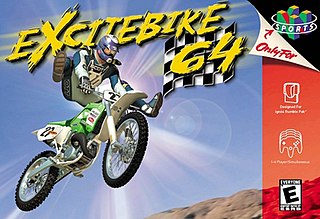
Excitebike 64 is a video game published by Nintendo and developed by Left Field Productions. It was released for the Nintendo 64 on May 2, 2000 in North America, June 23 in Japan, and June 8, 2001, in Europe. It is the second installment in the Excite series, acting as a sequel to Excitebike on the NES, and is the first 3D game in the series. Many real-life dirt bike gear brands are extensively featured throughout the game, such as Bell Helmets, Alpinestars and No Fear.
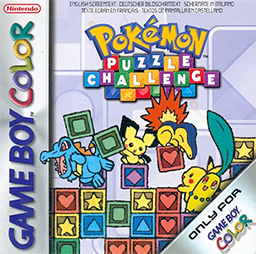
Pokémon Puzzle Challenge is a puzzle video game developed by Intelligent Systems and published by Nintendo for the Game Boy Color. Released in Japan on September 21, 2000; in North America on December 4, 2000; and in PAL regions on June 15, 2001, it is the second Pokémon-themed entry in the Puzzle League series. While its Nintendo 64 counterpart Pokémon Puzzle League is visually based on the Pokemon anime, Puzzle Challenge instead draws inspiration from the Pokémon Gold and Silver games. The game features multiple modes of play and support for competitive play between two players. Puzzle Challenge was later digitally re-released via the Nintendo 3DS's Virtual Console line on November 6, 2014.

Wave Race: Blue Storm is a jetski racing video game developed and published by Nintendo for the GameCube in late 2001. It is the sequel to the 1996 Nintendo 64 game Wave Race 64, and the third in the series that started with the 1992 Game Boy game Wave Race.
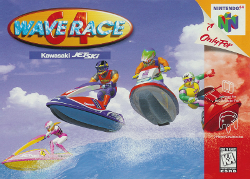
Wave Race 64 is a 1996 racing video game developed and published by Nintendo for the Nintendo 64. Gameplay involves the player racing on a personal watercraft on a variety of courses while successfully manoeuvring the vehicle around various buoys. A multiplayer mode where two players can compete against each other on a chosen course is also included. The game supports the Controller Pak, which allows players to transfer saved data from one game cartridge to another.
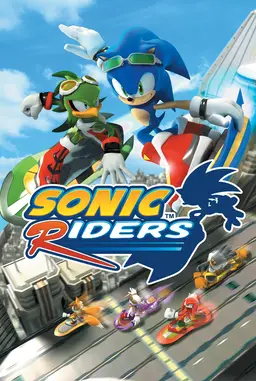
Sonic Riders is a 2006 racing video game for the GameCube, PlayStation 2, and Xbox in which the player controls characters from the Sonic the Hedgehog series on hoverboards. In the game's 16 tracks, the player competes against characters—either controlled by computers or other players—in story and battle modes. It was developed by Sonic Team and Now Production, published by Sega, and released in February 2006 in Japan and North America. It was released in Europe the following month and for Windows at the end of the year. A Game Boy Advance version developed by Backbone Entertainment was canceled.
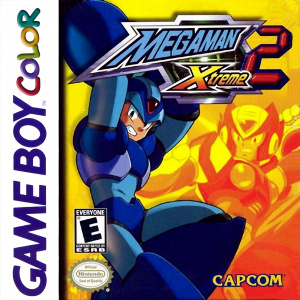
Mega Man Xtreme 2 is an action-platform video game that was developed and published by Capcom for the Game Boy Color. It is a spin-off title in the Mega Man X series and a follow-up to Mega Man Xtreme, which was released the previous year. Mega Man Xtreme 2 is set in the 22nd century between the events of Mega Man X3 and Mega Man X4. The DNA souls of robots known as "Reploids" are being stolen and used to create an army of undead "Mavericks". The "Maverick Hunters" X and Zero quickly spring into action with the help of their young ally Iris.

Mickey's Speedway USA is a Disney racing game for the Nintendo 64 and Game Boy Color, developed by Rareware and published by Nintendo under license from Disney Interactive. It is styled after other kart racers such as Mario Kart 64 and Diddy Kong Racing, and features characters from the Mickey Mouse universe racing across the United States. It is Rare and Nintendo's second Disney-themed racing game following Mickey's Racing Adventure (1999).

Motocross Maniacs is a platform racing video game released in 1989 by Konami, for the Game Boy handheld.

Hercules: The Legendary Journeys is a video game developed by Player 1 and published by Titus Interactive for the Nintendo 64 in 2000 and developed and published by Titus Interactive for the Game Boy Color in 2001. The game is licensed from the 1995 television series of the same name, and the Game Boy Color title was released by Titus Interactive alongside Xena: Warrior Princess in the same month, with both games having linked features using the Game Link Cable.
Cruis'n is a series of racing video games originally developed by Eugene Jarvis for Midway Games and published by Midway and Nintendo. The series distinguishes itself from other racing games with its over-the-top presentation and fast-paced gameplay, featuring a wide variety of vehicles and tracks based on a variety of real world locations. The series debuted in North American and European arcades in 1994 with the release of Cruis'n USA, which, along with Killer Instinct, was advertised as running on Nintendo's Ultra 64 hardware. Two sequels followed, Cruis'n World and Cruis'n Exotica, which featured new vehicles and tracks. All three games were released for the Nintendo 64 as well, with Exotica also being released for the handheld Game Boy Color. The next game in the series, Cruis'n Velocity deviated from the traditional arcade gameplay of the series and was released for the Game Boy Advance.
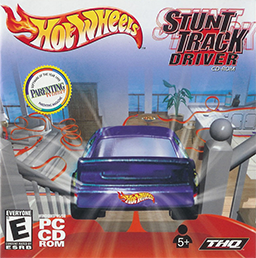
Hot Wheels Stunt Track Driver is a racing video game developed by Semi Logic Entertainments and published by Mattel Media for Microsoft Windows. It is based on the Hot Wheels toy franchise, and was released on October 15, 1998. A Game Boy Color version, developed by Lucky Chicken Games, was released in 2000.

F-Zero Climax is a racing video game developed by Suzak Inc. and published by Nintendo for the Game Boy Advance (GBA) handheld console. The game was released in Japan on October 21, 2004 and was the last F-Zero installment for the next 19 years.

Hot Wheels: Burnin' Rubber is a 2001 racing video game developed by Altron and published by THQ for the Game Boy Advance. The game is based on the Hot Wheels toy series.

Cubix: Robots for Everyone: Race 'n Robots is a 2001 racing game developed by Blitz Games and published by The 3DO Company, based on the Cubix: Robots for Everyone television series.

Supercross Freestyle is a 2000 motorbike racing game developed by Fernando Velez and Guillaume Dubail, and published by Infogrames Europe SA for the Game Boy Color. The game features three modes, including a conventional supercross racing mode, a freestyle trick mode, and an arcade racing mode. Supercross Freestyle received praise upon release for the diversity of game modes and controls.



















